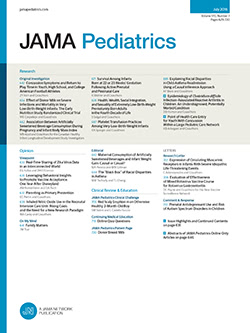高氧延迟脐带夹紧在极早产儿:一项随机临床试验。
IF 18
1区 医学
Q1 PEDIATRICS
引用次数: 0
摘要
重要性:高氧延迟脐带夹紧(DCC)可减少早产新生儿早期缺氧。然而,这种方法的安全性和有效性从未被研究过。目的探讨早产儿DCC窗期面罩100%供氧与不含高氧血症的30%供氧相比,是否因持续混合脐静脉血而减少低氧血症。设计、环境和参与者该双盲随机临床试验于2021年11月至2024年10月在加州的2所大学和1所私立医疗中心进行。参与者包括140名早产儿(出生在妊娠22至28周)。这些数据是从2024年11月到2025年5月进行分析的。干预措施在DCC期间,婴儿通过面罩接受持续气道正压通气或正压通气,并使用隐蔽搅拌器随机分为30%(低氧组)或100%(高氧组)。在脐带被夹住并切断后,每个婴儿按照当代指南(30%氧气和根据外周氧饱和度滴定)进行复苏。主要结局:主要结局是出生后5分钟外周血氧饱和度达到80%的婴儿数量。结果随机选取140例婴儿(平均胎龄26周;女性69例(49%),男性71例(51%))。在低氧组中,72名婴儿中有28名(39%)在5分钟内达到80%的外周氧饱和度,而在高氧组中,68名婴儿中有47名(69%)达到80%(校正优势比为3.74;95% ci, 1.80-7.79;p < 0.001)。两组之间的绝对风险差为0.3 (95% CI, 0.26-0.35),表明高氧组在出生后5分钟发生低氧血症的风险降低30%。DCC术后复苏时吸氧最大中位分数、脐动脉动脉血氧分压、严重脑室内出血、经后40周前死亡组间差异无统计学意义。结论和相关性在本研究中,DCC期间100%供氧可减少早期低氧血症,但不增加发病率。需要一项大型随机临床试验来确定DCC期间100%供氧是否能提高极早产儿的生存率并降低其长期发病率。临床试验注册号:NCT04413097。本文章由计算机程序翻译,如有差异,请以英文原文为准。
Deferred Cord Clamping With High Oxygen in Extremely Preterm Infants: A Randomized Clinical Trial.
Importance
Deferred cord clamping (DCC) with high oxygen may reduce early hypoxia in preterm newborns. However, the safety and efficacy of this procedure has never been studied.
Objective
To determine whether providing 100% oxygen by face mask during the window of DCC in preterm infants reduces hypoxemia compared with 30% oxygen without hyperoxemia due to the continued mixing with umbilical venous blood.
Design, Setting, and Participants
This double-blinded randomized clinical trial took place from November 2021 to October 2024 at 2 universities and 1 private medical center in California. Participants included 140 preterm infants (born at 22 to 28 weeks' gestation). These data were analyzed from November 2024 to May 2025.
Interventions
During DCC, infants received continuous positive airway pressure or positive pressure ventilation via face mask and were randomized to either 30% (low oxygen group) or 100% (high oxygen group) using a concealed blender. After the umbilical cord was clamped and cut, each infant was resuscitated per contemporary guidelines (30% oxygen and titration based on saturation of peripheral oxygen).
Main Outcome
The primary outcome was the number of infants who achieve peripheral oxygen saturations of 80% by 5 minutes of life.
Results
There were 140 infants randomized (mean gestational age, 26 weeks; 69 female [49%] and 71 male [51%]). In the low oxygen group, 28 of 72 infants (39%) achieved a peripheral oxygen saturation of 80% by 5 minutes compared with 47 of 68 infants (69%) in the high oxygen group (adjusted odds ratio, 3.74; 95% CI, 1.80-7.79; P < .001). The absolute risk difference between the 2 groups was 0.3 (95% CI, 0.26-0.35), indicating that the high oxygen group had a 30% lower risk of experiencing hypoxemia 5 minutes after birth. Maximum median fraction of inspired oxygen during resuscitation after DCC, umbilical arterial partial pressure of oxygen in arterial blood, severe intraventricular hemorrhage, and death before 40 weeks' postmenstrual age were not different between groups.
Conclusion and Relevance
In this study, 100% oxygen during DCC reduced early hypoxemia without increased morbidity. A large randomized clinical trial is needed to determine if 100% oxygen during DCC improves survival and reduces longer-term morbidities in extremely preterm infants.
Trial Registration
ClinicalTrials.gov Identifier: NCT04413097.
求助全文
通过发布文献求助,成功后即可免费获取论文全文。
去求助
来源期刊

JAMA Pediatrics
PEDIATRICS-
CiteScore
31.60
自引率
1.90%
发文量
357
期刊介绍:
JAMA Pediatrics, the oldest continuously published pediatric journal in the US since 1911, is an international peer-reviewed publication and a part of the JAMA Network. Published weekly online and in 12 issues annually, it garners over 8.4 million article views and downloads yearly. All research articles become freely accessible online after 12 months without any author fees, and through the WHO's HINARI program, the online version is accessible to institutions in developing countries.
With a focus on advancing the health of infants, children, and adolescents, JAMA Pediatrics serves as a platform for discussing crucial issues and policies in child and adolescent health care. Leveraging the latest technology, it ensures timely access to information for its readers worldwide.
 求助内容:
求助内容: 应助结果提醒方式:
应助结果提醒方式:


